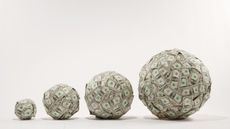Three Sectors for the Recovery
These areas -- and funds that focus on them -- should do well when the recession ends. Plus, two sectors to weather the downturn.
The U.S. economy may be in a recession, but the stock market is already looking ahead to better days. Now is a good time to position your portfolio for the recovery and bull market that are sure to come.
We don't know when the economy will turn the corner, but we have a pretty good idea of what types of investments will do well when it does. Banks and other financial-services firms, for example, tend to prosper, thanks to low interest rates and renewed demand for credit. Small-company stocks have also performed well historically. Knowing which types of stocks do well at any given stage in the business cycle will help you buy good funds before the sectors they reflect begin their upswing.
The proliferation of index funds and exchange-traded funds that track stock sectors and other narrow slices of the market makes it easy to tweak your portfolio to take advantage of market cycles. But caution is in order. Don't heavily tilt your portfolio toward just a few sectors -- a balanced portfolio is always the best approach. Sector bets are best limited to a small portion of your portfolio.

Sign up for Kiplinger’s Free E-Newsletters
Profit and prosper with the best of expert advice on investing, taxes, retirement, personal finance and more - straight to your e-mail.
Profit and prosper with the best of expert advice - straight to your e-mail.
With that in mind, let's take a quick tour of the ups and downs of a typical business cycle.
Nearing bottom. Although stocks typically react to economic changes six to nine months before they occur, this recession could be a lengthy one. That's why it makes sense to consider defensive sectors -- those that do well when the economy crumples. Traditionally, they include utilities, consumer staples and health care.
Utilities, however, operate on lots of borrowed money. Given the turmoil in the credit markets, it may be best to avoid high-debt companies for now. Consumer staples have done well -- up 23% in 2008 -- to the point that some analysts think they're overpriced. Nevertheless, Standard & Poor's currently considers consumer staples one of only four sectors worth over-weighting in your portfolio (the others are energy, telecommunications and health care).
The Consumer Staples Select Sector SPDR (symbol XLP) is a good way to own a group of these stocks. The ETF is filled with top-quality companies, such as Procter & Gamble and Wal-Mart, and has a low annual expense ratio of 0.23%.
Another S&P sector recommendation, health care, also happens to be the only sector that Brad Sorensen, director of sector research at Charles Schwab, currently rates a buy. Among exchange-traded funds that track health care, our favorite is Vanguard Health Care (VHT), which has a large helping of cheap pharmaceutical companies and boasts a low, 0.2% annual expense ratio.
We also like the T. Rowe Price Health Sciences fund (PRHSX), which is more expensive to own (expense ratio: 0.83%) because it is not an index fund. Its holdings are managed by a doctor, Kris Jenner, who has lately favored large biotech companies. The fund's five-year annualized return is a respectable 6.9%.
Turning around. Interest rates usually fall during an economic slowdown to encourage new borrowing. That's why investors often pile into financial-sector stocks when prospects are darkest. Valuations are certainly tempting. A lot of troubled bank stocks are trading for well below their book value, a level that used to signal bargain territory.
But this cycle will surely be unlike others. Thanks to a federal rescue plan, taxpayers now own a piece of many of our largest banks, and tougher regulation is on the horizon. "We're still trying to get a handle on what the financial industry will look like as we come to the conclusion of this crisis," says Schwab's Sorensen. Best to take a pass on this sector for now. The same goes for homebuilders, another group of stocks that has traditionally done well coming out of a recession. Strapped consumers aren't likely to buy new homes in large numbers anytime soon.
Investors looking ahead to the next period of economic expansion should instead consider three areas: consumer-discretionary stocks, technology stocks, and small-company stocks.
The consumer-discretionary sector includes automakers, hotels and restaurants, media companies, and retailers. Their stocks take a big hit in a downturn but can rise quickly when investors sense the economy is about to expand. An ETF, the iShares Consumer Discretionary SPDR (XLY), closely tracks these stocks. Among its top holdings are McDonald's, cable giant Comcast, Walt Disney and Home Depot.
Jumping into this sector too early can be risky, though. Shares of the ETF fell 15% during the three months that ended January 30. On the other hand, Morningstar estimates that stocks represented by this ETF are collectively trading at a 30% discount to their fair value.
Technology stocks also traditionally rise quickly in anticipation of a recovery, when corporate purse strings loosen and big-ticket technology projects are taken off the back burner. Here, we like the Technology Select Sector SPDR (XLK), which tracks the 79 technology stocks in the S&P 500. Its top holdings include Microsoft, Cisco, Apple, Intel and Google, all of which have recently been trading at steep discounts to their historical valuations.
Small-company stocks are another bellwether of better times. When investors sense a recovery, they become more willing to take on the added risk involved in owning small, often unproven companies. Here we like the iShares S&P SmallCap 600 Growth fund (IJT). Small-company indexes can suffer from high turnover, which increases the cost of ownership. But this ETF tracks a relatively low-turnover index, and it has a rock-bottom expense ratio (0.25%) to boot.
Picking up steam. Once the economy has turned the corner and is growing steadily, several other sectors come into favor. Although this part of the cycle is still a long way off, it's good to know what lies ahead.
Makers of industrial machinery and heavy equipment begin to do well as revenues rise enough to cover their high fixed costs. A little further into the cycle, energy and commodity stocks do well as increased business activity and rising consumer spending stoke demand. S&P's current recommendation of energy contradicts its traditional role as a late-cycle sector. But S&P says it remains positive on the big, integrated oil companies (think ExxonMobil) that make up 70% of the sector's market value.
Among energy ETFs, our favorite is the Energy Select Sector SPDR (XLE), which includes all the S&P 500's energy companies. We also like the T. Rowe Price New Era fund (PRNEX), guided by longtime manager Charles Ober.
-
 Pros and Cons of Waiting Until 70 to Claim Social Security
Pros and Cons of Waiting Until 70 to Claim Social SecurityWaiting until 70 to file for Social Security benefits comes with a higher check, but there could be financial consequences to consider for you and your family.
By Patrick M. Simasko, J.D. Published
-
 Now Could Be Time for Private Investors to Make Their Mark
Now Could Be Time for Private Investors to Make Their MarkThe venture capital crunch may be easing, but it isn't over yet. That means there could be direct investment opportunities for private deal investors.
By Thomas Ruggie, ChFC®, CFP® Published
-
 The 5 Best Actively Managed Fidelity Funds to Buy Now
The 5 Best Actively Managed Fidelity Funds to Buy Nowmutual funds In a stock picker's market, it's sometimes best to leave the driving to the pros. These Fidelity funds provide investors solid active management at low costs.
By Kent Thune Last updated
-
 The 12 Best Bear Market ETFs to Buy Now
The 12 Best Bear Market ETFs to Buy NowETFs Investors who are fearful about the more uncertainty in the new year can find plenty of protection among these bear market ETFs.
By Kyle Woodley Published
-
 Don't Give Up on the Eurozone
Don't Give Up on the Eurozonemutual funds As Europe’s economy (and stock markets) wobble, Janus Henderson European Focus Fund (HFETX) keeps its footing with a focus on large Europe-based multinationals.
By Rivan V. Stinson Published
-
 Best Bond Funds to Buy
Best Bond Funds to BuyInvesting for Income The best bond funds provide investors with income and stability – and are worthy additions to any well-balanced portfolios.
By Jeff Reeves Last updated
-
 Vanguard Global ESG Select Stock Profits from ESG Leaders
Vanguard Global ESG Select Stock Profits from ESG Leadersmutual funds Vanguard Global ESG Select Stock (VEIGX) favors firms with high standards for their businesses.
By Rivan V. Stinson Published
-
 Kip ETF 20: What's In, What's Out and Why
Kip ETF 20: What's In, What's Out and WhyKip ETF 20 The broad market has taken a major hit so far in 2022, sparking some tactical changes to Kiplinger's lineup of the best low-cost ETFs.
By Nellie S. Huang Published
-
 ETFs Are Now Mainstream. Here's Why They're So Appealing.
ETFs Are Now Mainstream. Here's Why They're So Appealing.Investing for Income ETFs offer investors broad diversification to their portfolios and at low costs to boot.
By Nellie S. Huang Published
-
 Do You Have Gun Stocks in Your Funds?
Do You Have Gun Stocks in Your Funds?ESG Investors looking to make changes amid gun violence can easily divest from gun stocks ... though it's trickier if they own them through funds.
By Ellen Kennedy Published